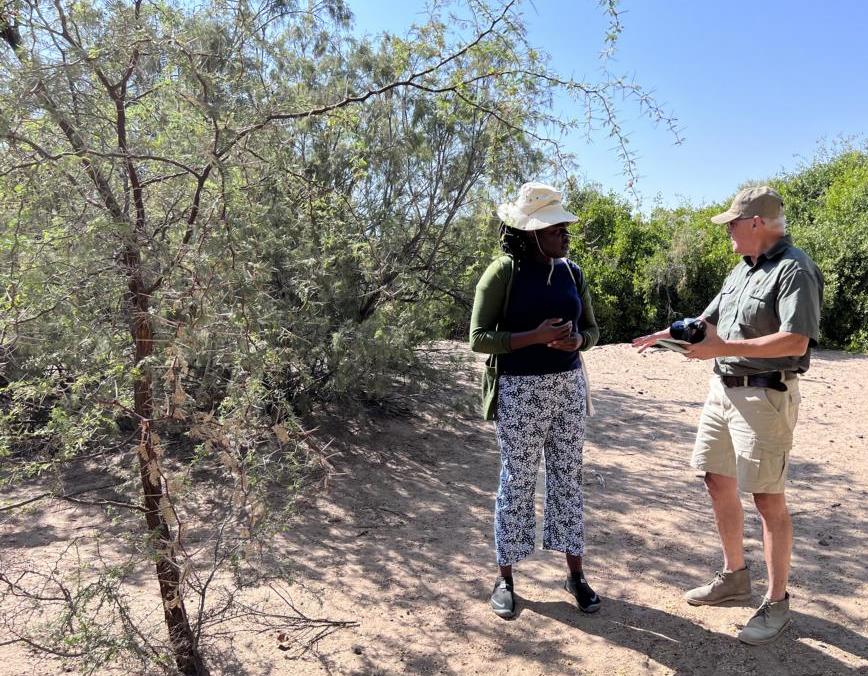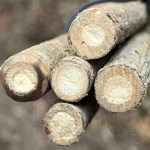Camelthorn is an excellent firewood in Southern Africa. Its outer layer is light-colored sapwood, and its dark, hard, and heavy heartwood is inside. This hardwood produces long-lasting coals and high heat. Its northernmost distribution area extends from the Northern Cape province of South Africa to Angola and Zambia.

How did the name for Camelthorns arise?
Camelthorn (Vachellia erioloba) got its English common name from the Afrikaans name for giraffes. When the Dutch Boers landed in 1652 in South Africa, they found various exotic plants and animals for which they did not have a name. When they saw giraffes, they thought these were camels with the gait of horses. And therefore called them ‘Kameelperd’ (Camelhorse). When Carl Linnaeus named giraffes in 1758, he took the species name the Afrikaans word and called them Giraffa camelopardalis. And as giraffes liked to feed on the pods of this thorn tree, the common name of ‘Camelthorn’ stuck.

Why is Camelthorn not an acacia?
The development of the scientific name for this tree is exciting and stormy. From 1754 up to 2011, it was called Acacia erioloba. ‘Acacia’ is self-explaining, and ‘erioloba’ means ‘wooly lobe,’ as the pods look very much like the velvety-haired earlobes of humans.

But then, an emotional battle between scientists from Australia and South Africa evolved about the scientific naming of the group of yellow-flowered, pod-producing plants known as wattles, mimosas, thorn trees, and acacias. In the end, the Australians won. At the 17th International Botanical Congress, held in Melbourne in 2011, it was decided that all African species of this group would be newly grouped into the genera Vachellia and Senegalia (Mimosas). See here. Therefore, no acacias are native to Africa anymore.

Due to having spines and round, head-like flowers, Camelthorn was grouped into the genus Vachellia.
Value of Camelthorn as firewood
According to the Wood database, the average dried weight (density) of the heartwood is around 74 lbs/ft3 (1,185 kg/m3).
Densities of other woods for comparison are as follows:
- African Blackwood (Dalbergia melanoxylon): 79 lbs/ft3 (1.270 kg/m3) – that’s the hardest wood in Africa
- European beech (Fagus sylvatica): 44.3 lbs/ft3 (710 kg/m3)
- English Oak (Quercus robur): 42 lbs/ft3 (675 kg/m3)
- Scots pine (Pinus sylvestris): 34 lbs/ft3 (550 kg/m3)
Not only is the density of Camelthorn wood high, but its calorific value is also high when burning.

Dr. Martina Meincken writes in this article: ‘The calorific value of wood can be related to its chemical composition and varies between 17 – 20 MJ/kg for oven-dry wood. Major elements contributing to the calorific value are carbon, hydrogen, and oxygen, whereas nitrogen and some inorganic components contribute to toxic waste gases.’
According to this source, Camelthorn wood has a calorific value of 19,03 MJ/kg, as high wood densities are directly related to high calorific values. This results in a high energy content (high heat) and a slow-burning process. Another excellent firewood in Southern Africa is Red Bushwillow (Combretum apiculatum).
Disadvantage of Camelthorn as firewood

There is one – minor – setback of Camelthorn wood. This is the ash content, around 2,8% of burned volume. Ideally, the remaining ash amount should be below 1% to optimize energy output and to be able to roast meat directly on the coals. Therefore, griddles should be used for roasting when burning camelthorn firewood.
Other uses of Camelthorn trees
All other uses of Camelthorn trees will be described in future articles. At this point, giving a very brief overview of these uses should suffice. From wounds in the cambium layer of camelthorn trees, an edible and sweet-tasting gum is oozing. It is more gummy and not as much as the edible resin described here. The color of this gum is amber and transparent, and local people, monkeys, baboons, and birds like to eat it. The stripped and pounded inner bark is used for ropes and strings. The spongy inside layer of young pods was used as a famine food by the Topnaar people in the Kuiseb area. Ripe seeds can also be roasted and ground to produce a substitute for coffee.
Lessons learned about Camelthorn as firewood:
- Both Common English- and their scientific names have an interesting history.
- When burning, camelthorn wood has a very high average dried weight (density) and high calorific value.
- Combined with its high carbon content, it produces lots of heat and burns slowly.
- The disadvantage is an elevated ash content, which is not ideal for roasting food directly on the coals.
- Besides prime firewood, camelthorn trees deliver edible gum and inner bark strings.
.





